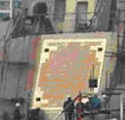Based on what I have gathered, the first version of the radar is a S-band AESA, with an octagonal antenna of about 4m diameter. The AESA is built out of quad TRMs, with each quad capable of 100W peak RF power. Total number of quads is estimated to be 1250, for a total of 5000 T/R elements and 125kW peak RF power per antenna. First version of the radar employed air cooling.
The S-band antenna is sandwiched between two C-band arrays. According to one rumor, the function of the C-band arrays is to provide uplink/downlink communication with the principle weapon of the the Type 052C destroyer: HQ-9. The missile itself uses active radar homing to target. Another theory is that the C-band arrays are illuminators and the missiles SARH or TVM. However their rectangular shape does not seem optimal for that role.
Only known photo of the S-band/C-band antenna, taken from a type 052C fitting out

What do you guys think? Was the Chinese state of the art really at this level in the early 2000s? The USN put to sea its first S-band AESA (SPY-4) radar a full decade later and was also late to the party in introducing a long range ARH SAM.
The S-band antenna is sandwiched between two C-band arrays. According to one rumor, the function of the C-band arrays is to provide uplink/downlink communication with the principle weapon of the the Type 052C destroyer: HQ-9. The missile itself uses active radar homing to target. Another theory is that the C-band arrays are illuminators and the missiles SARH or TVM. However their rectangular shape does not seem optimal for that role.
Only known photo of the S-band/C-band antenna, taken from a type 052C fitting out

What do you guys think? Was the Chinese state of the art really at this level in the early 2000s? The USN put to sea its first S-band AESA (SPY-4) radar a full decade later and was also late to the party in introducing a long range ARH SAM.

